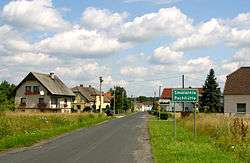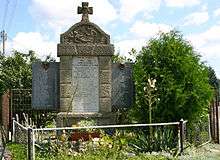Smolarnia, Opole Voivodeship
Smolarnia [smɔˈlarɲa], German Pechhütte is a village in the administrative district of Gmina Strzeleczki (Gemeinde Klein Strehlitz), within Krapkowice County, Opole Voivodeship, in Upper Silesia in south-western Poland.[1] It lies approximately 7 kilometres (4 mi) west of Strzeleczki, 14 km (9 mi) west of Krapkowice, and 23 km (14 mi) south-west of the regional capital Opole.
Smolarnia Pechhütte | |
|---|---|
Village | |
 | |
 Smolarnia Pechhütte | |
| Coordinates: 50°29′N 17°47′E | |
| Country | |
| Voivodeship | Opole |
| County | Krapkowice |
| Gmina | Strzeleczki |
| Elevation | 186 m (610 ft) |
Before 1945 the area was part of Germany (see Territorial changes of Poland after World War II). Since 2006 the village, like the entire commune, has been bilingual in German and Polish.
The village has a population of 252 inhabitants. The nearby hamlet of Serwitut (Servitut), with a population of 69 people, is administered as part of this village.
History


The village can trace its history back to 12 November 1663, when a large estate was granted to a nobleman which later became the center of the new town, attracting settlers from nearby villages.[2] The village's name was first recorded as Dziedzützer Pechhüte, indicating it was a hamlet of Dziedzice (as was nearby Servitut). Its name derives from the pitch industry that occupied the villagers. The Polish name, Smolarnia, does not appear before the 19th century, and was first recorded in an official record from 1828.[3] The parish church for Pechhütte and Servitut was in Polnisch Rasselwitz.
German documents of the early 19th century do not provide separate census data for Pechhütte and Servitut, but in the 1830s there were counted between Pechhütte, Servitut, and Sedschütz 44 households with 420 inhabitants. By the 1890s there were 25 families living in the village. However, there was very little arable land, as much of the area was taken up by the forest, an Easement property called the Oberglogauer Servitutwald because it was owned by the wealthy Oppersdorff family from Oberglogau. So, many of the villagers had to work in the forest and on nearby estates. In World War I several soldiers from the village died, but the village itself, like most of Germany, was untouched by physical damage. In 1915, Pechhütte and Servitut had 1111 inhabitants.
In the Upper Silesia plebiscite of 20 March 1921 541 villagers voted to remain with Germany and 321 voted to join the newly created state of Poland. As a result, Pechhütte remained in Germany. Before 1945 it belonged to the district of Landkreis Neustadt O.S. Up until 1945 the forest around Pechhütte, by then known as the Sedschützer Servitutwald belonged to Count Klaus von Tiele-Winkler of Moschen. During the war, the town suffered minimal damage, with only the school burning down.
In 1945 Silesia was given to Poland and the German population of Pechhütte was largely expelled, dramatically reducing the town's population; it has not since reached its former size. The village was renamed Smolarnia and annexed to the newly created Silesian Voivodeship. In 1950 it was reassigned to Opole Voivodeship, and in 1999 reassigned from Prudnik County (formerly Neustadt O.S.) to Krapkowice County. On 17 May 2006 the entire commune of Strzelecki/Klein Strehlitz was declared bilingual in German and Polish, and on 24 November 2008 the old name German name Pechhütte was also made official.
In the center of the town is a memorial to the soldiers from Pechhütte killed in World War I and II.
References
- "Central Statistical Office (GUS) – TERYT (National Register of Territorial Land Apportionment Journal)" (in Polish). 2008-06-01.
- "Official website" (in Polish).
- "Commune website" (in Polish).
| Wikimedia Commons has media related to Smolarnia. |